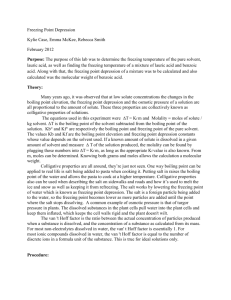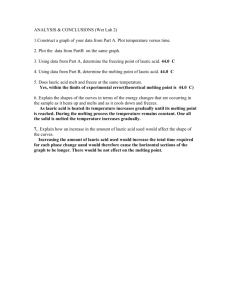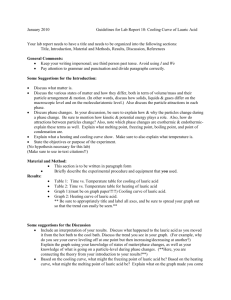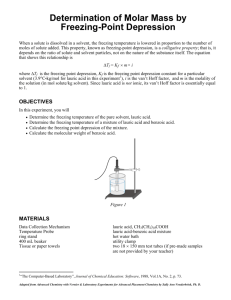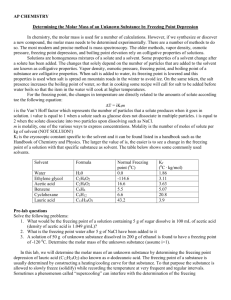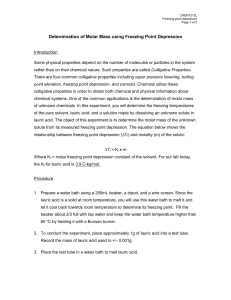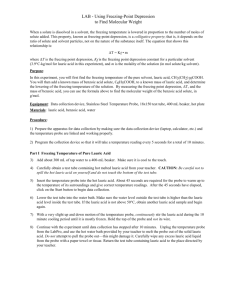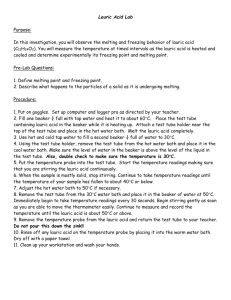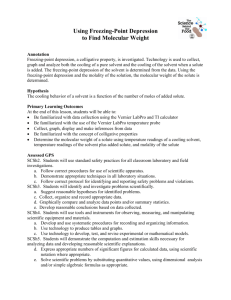Experiment 12 Freezing Point - Kingsborough Community College
advertisement
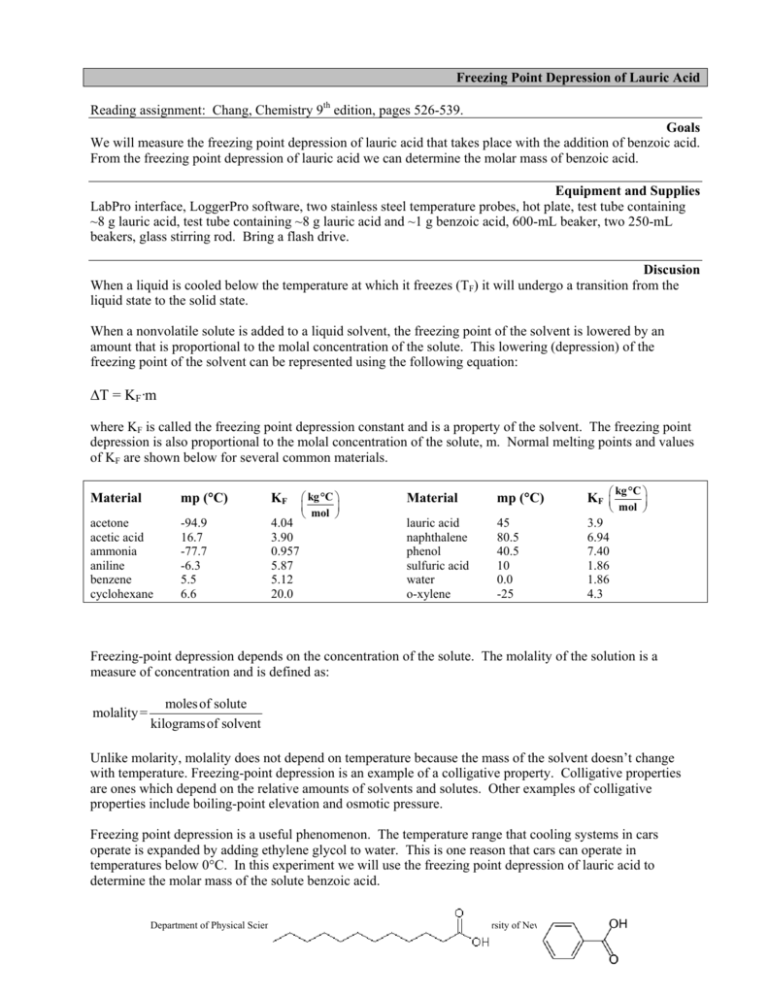
Freezing Point Depression of Lauric Acid Reading assignment: Chang, Chemistry 9th edition, pages 526-539. Goals We will measure the freezing point depression of lauric acid that takes place with the addition of benzoic acid. From the freezing point depression of lauric acid we can determine the molar mass of benzoic acid. Equipment and Supplies LabPro interface, LoggerPro software, two stainless steel temperature probes, hot plate, test tube containing ~8 g lauric acid, test tube containing ~8 g lauric acid and ~1 g benzoic acid, 600-mL beaker, two 250-mL beakers, glass stirring rod. Bring a flash drive. Discusion When a liquid is cooled below the temperature at which it freezes (TF) it will undergo a transition from the liquid state to the solid state. When a nonvolatile solute is added to a liquid solvent, the freezing point of the solvent is lowered by an amount that is proportional to the molal concentration of the solute. This lowering (depression) of the freezing point of the solvent can be represented using the following equation: T = KF·m where KF is called the freezing point depression constant and is a property of the solvent. The freezing point depression is also proportional to the molal concentration of the solute, m. Normal melting points and values of KF are shown below for several common materials. Material mp (C) KF acetone acetic acid ammonia aniline benzene cyclohexane -94.9 16.7 -77.7 -6.3 5.5 6.6 4.04 3.90 0.957 5.87 5.12 20.0 kg °C mol Material mp (C) kg °C KF lauric acid naphthalene phenol sulfuric acid water o-xylene 45 80.5 40.5 10 0.0 -25 3.9 6.94 7.40 1.86 1.86 4.3 mol Freezing-point depression depends on the concentration of the solute. The molality of the solution is a measure of concentration and is defined as: molality = moles of solute kilograms of solvent Unlike molarity, molality does not depend on temperature because the mass of the solvent doesn’t change with temperature. Freezing-point depression is an example of a colligative property. Colligative properties are ones which depend on the relative amounts of solvents and solutes. Other examples of colligative properties include boiling-point elevation and osmotic pressure. Freezing point depression is a useful phenomenon. The temperature range that cooling systems in cars operate is expanded by adding ethylene glycol to water. This is one reason that cars can operate in temperatures below 0°C. In this experiment we will use the freezing point depression of lauric acid to determine the molar mass of the solute benzoic acid. Department of Physical Sciences Kingsborough Community College The City University of New York Winter 2010 1 ethylene glycol (component in antifreeze) lauric acid benzoic acid Procedure SAFETY PRECAUTIONS Proper eye protection must be worn throughout this experiment. The wires for temperature probes must be kept away from the hot plate. Students work in groups of 2-3, depending on the availability of computer workstations. 1. Prepare a sample of pure lauric acid. Obtain about 8 g of lauric acid and place it in a clean dry test tube. Use a pen to label the test tube as the lauric acid. 2. Prepare a mixture of lauric acid and benzoic acid. Obtain about 8 g of lauric acid and place it in a second clean dry test tube. Record the mass of the lauric acid in the Data Sheet. Add about 1 g of benzoic acid to the lauric acid in this second test tube. Record the mass of the benzoic acid in the Data Sheet. Use a glass stirring rod to mix the two solids. Use a pen to label the test tube as the mixture. 3. Fill two 250 mL beakers with about 200 mL of tap water. 4. Place the two test tubes containing the solids into a 600 mL beaker containing about 400 mL of hot water. The temperature of the water should be between 65°C and 80°C. Allow both solids to fully melt. 5. Open the LoggerPro application. Select the folder Chemistry with Computers. Select the module titled Freezing Point (Experiment 15). 6. If only one temperature is shown in the real time monitor select Experiment Set up Sensors Show all Interfaces. Click on CH2 and Choose SensorsStainless Steel Temperature. The realtime monitor should now show two temperature readings. To display both sensor readings on the graph double click on the graph and select Axes Options from the pop-up menu. Select Temperature 2. 7. Experimental parameters are controlled using the Experiment menu. Use the Data collection option in the Experiment menu to change the experiment length and sampling rate: Mode = Timed Based Sampling Rate = 15 samples/minute Length = 10 minutes Oversampling = Not Selected 8. Select the vertical axis of the graph and change the temperature range to 20°C to 80°C. 9. If the solids are completely melted, then place the Channel 1 temperature probe into the test tube containing the lauric acid. Place the Channel 2 temperature probe into the test tube containing the lauric acid/benzoic acid mixture. 10. Allow the temperature probes to equilibrate with the samples, meaning that the temperature should be stable. This may take a couple of minutes. Once they have equilibrated, begin collecting data by selecting the start function. The system will begin acquiring, recording, and displaying data on the graph screen. 2 11. Once 30-60 seconds of data has been displayed on the screen pull the test tubes with the temperature probes out of the hot water bath and place each one into one of the 250 mL beakers containing room temperature water. 12. Gently mix the samples by moving the temperature probes up and down slightly. Don't allow the temperature probes to move more than an inch up and down. Continue this motion until the samples begin to freeze. 13. The instrument will stop acquiring data automatically at the end of the ten minute run. 14. The experiment can be repeated, if necessary, by placing the test tubes back into the hot water and starting over. 15. Once the experiment is successfully completed, place the test tubes with the probes in the hot water bath and allow the solids to melt. Once the solids have melted pull out the temperature probes and wipe them clean with a paper towel. The samples should be poured into a waste container provided or re-used by the next group. 16. Save the data set to a flash drive before moving to the analysis of the graph. 3 Temperature (C) Calculations 1. Determine the freezing point of the pure lauric acid. Pure substances freeze at a constant temperature. This temperature is found by taking the average (mean) of data from the flat part of the cooling curve. Select the flat section of the curve with the cursor and then select the Statistics option from the Analysis menu. The window should now 90 display statistics for the region you selected, Cooling Curve for Pure Substance 80 including the mean temperature. The mean 70 temperature is the freezing point of the pure 60 substance. Record this value in the Data Flat part of curve 50 Sheet. 40 Temperature (C) 30 2. The freezing point of the mixture requires a different method of analysis. The 20 temperature of a freezing mixture is not 10 constant, so taking the average temperature 0 of a flat part of the cooling curve is not 0 2 4 Curve for Mixture 6 8 10 Cooling 90 time (minutes) possible. To determine the freezing point of line-of-best-fit for 80 the mixture we need to draw two lines-ofearly part of curve 70 best-fit and determine the temperature at Data which they intersect. One line-of-best-fit is 60 drawn in the region of the dramatic initial line-of-best-fit for 50 early part of curve decrease in temperature. The second line-of40 best-fit is drawn in the approximately flat 30 region near the end of the experiment. Each 20 line-of-best-fit has a slope and y-intercept. 10 The freezing point is the temperature at 0 which the two lines intersect. The 0 1 2 3 4 5 6 7 8 9 10 intersection of the two lines occurs at time (minutes) b m -b m y = 1 2 2 1 = TFREEZING where m1 and b1 m 2 - m1 are the slope and y-intercept for the first line and m2 and b2 are the slope and y-intercept for the second line. The linear fits are determined by using the curve fitting option in the analysis menu. Once these fits are made and the intercept is determined, record the freezing point in the Data Sheet. Title the graph to give information concerning which materials were studied. Once the two cooling curves have been analyzed save the file to a diskette and print a copy of the graph (not the data) in Landscape mode. 3. To determine the molar mass of the solute (benzoic acid) we need to use the mass of the benzoic acid and calculate the number of moles of benzoic acid in the mixture because: molar mass = mass (g) mass of benzoic acid moles moles of benzoic acid measured directly calculated from FPD The mass of the benzoic acid in the mixture was measured and is reported in the data sheet. The moles of benzoic acid can be determined from the freezing point depression. 4 4. Use the freezing points of the two solids to determine T: T = TF, pure – TF, mixture The freezing point depression T = KF·m where KF is the molal freezing point depression constant and m is the molality of the solute. Molality is defined as : m = molessolute kg solvent Rearrangement gives: mol solute = (m) x (kg solvent) where kg of solvent is the mass of the solvent (lauric acid) in the mixture. This gives the moles of the solute. The mass of the lauric acid was measured in grams so a conversion to kilograms must be made (1 kg = 1000 g). 6. By combing the mass of the solute (measured) and the moles of solute (calculated in step 5) we can calculate the molar mass of the solute. 7. The molecular formula for benzoic acid is C7H6O2. From this formula we can calculate the molar mass and compare it to the experimentally determined result from step 6 in the calculations. %difference = MM formula - MM experimental MM formula x100 where MM is the molar mass. 5 Observations and Notes Date 6 Data Sheet Freezing Point Depression of Lauric Acid Name Date Mass of lauric acid in the mixture g Mass of lauric acid in the mixture kg Mass of benzoic acid g (1 kg = 1000 g) Calculations All calculations should be clearly shown on a separate piece of paper. TF for pure lauric acid °C TF for mixture (lauric acid + benzoic acid) °C Freezing point depression, T °C Molality of benzoic acid molkg–1 Moles of benzoic acid mol Molar mass (experimental) gmol–1 Molar mass (from formula) gmol–1 % difference 7 Calculations Sheet 8
